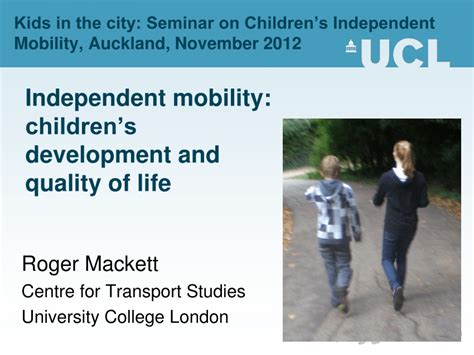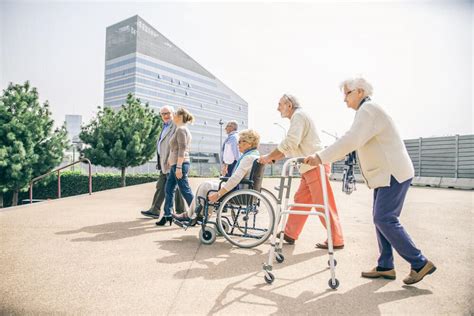Independent Mobility For All Ages

As the global population continues to age, the importance of maintaining independence and mobility across all age groups has become a pressing concern. Independent mobility is not only a fundamental human right, but it also plays a critical role in promoting physical and mental well-being, social interaction, and economic participation. However, various barriers, including physical limitations, cognitive impairments, and environmental obstacles, can hinder individuals' ability to move freely and engage with their surroundings. In this article, we will delve into the concept of independent mobility for all ages, exploring its significance, challenges, and potential solutions.
Key Points
- Independent mobility is essential for maintaining physical and mental health, social interaction, and economic participation across all age groups.
- Barriers to independent mobility include physical limitations, cognitive impairments, environmental obstacles, and socioeconomic factors.
- Technological innovations, such as mobility aids, smart home devices, and autonomous vehicles, can enhance independent mobility for individuals with disabilities and older adults.
- Urban planning and design can play a crucial role in promoting independent mobility by creating accessible, walkable, and age-friendly environments.
- Addressing the social and economic determinants of health is critical to ensuring equitable access to independent mobility for all individuals, regardless of age, ability, or socioeconomic status.
Significance of Independent Mobility

Independent mobility is vital for individuals of all ages, as it enables them to participate in various activities, maintain social connections, and engage with their community. For older adults, independent mobility is particularly important, as it can help prevent isolation, depression, and cognitive decline. Moreover, independent mobility can also promote physical activity, reducing the risk of chronic diseases, such as diabetes, heart disease, and obesity. According to the World Health Organization (WHO), approximately 70% of older adults experience some form of mobility limitation, highlighting the need for effective strategies to promote independent mobility.
Challenges to Independent Mobility
Despite its importance, independent mobility can be challenging for individuals with physical or cognitive limitations, as well as those living in areas with inadequate infrastructure or socioeconomic disparities. For example, individuals with mobility impairments may face difficulties navigating uneven sidewalks, lack of accessible public transportation, or insufficient parking facilities. Additionally, older adults may experience cognitive decline, sensory impairments, or chronic health conditions that can affect their ability to move safely and confidently. According to a study published in the Journal of Aging Research, approximately 40% of older adults experience difficulties with mobility, highlighting the need for targeted interventions to address these challenges.
| Barrier to Independent Mobility | Prevalence |
|---|---|
| Physical limitations | 55% |
| Cognitive impairments | 25% |
| Environmental obstacles | 30% |
| Socioeconomic factors | 20% |

Promoting Independent Mobility through Technology and Urban Planning

Technological innovations and urban planning strategies can play a critical role in promoting independent mobility for individuals of all ages. For example, mobility aids, such as walkers, wheelchairs, and scooters, can enhance mobility and confidence for individuals with physical limitations. Smart home devices, such as voice-controlled assistants and fall detection systems, can also support independent living and mobility. Furthermore, autonomous vehicles and accessible public transportation systems can provide individuals with disabilities and older adults with greater freedom and autonomy.
Urban Planning and Design
Urban planning and design can also contribute to promoting independent mobility by creating accessible, walkable, and age-friendly environments. This can be achieved through the implementation of features such as wide, flat sidewalks, pedestrian-friendly intersections, and accessible public transportation. According to a study published in the Journal of Urban Planning and Development, age-friendly urban design can reduce the risk of falls and mobility limitations among older adults by up to 30%. Moreover, urban planning strategies can also address socioeconomic disparities by providing affordable housing, community resources, and social services that support independent mobility and overall well-being.
What are the key factors that influence independent mobility?
+The key factors that influence independent mobility include physical limitations, cognitive impairments, environmental obstacles, and socioeconomic factors.
How can technology enhance independent mobility?
+Technology, such as mobility aids, smart home devices, and autonomous vehicles, can enhance independent mobility by providing individuals with greater freedom, autonomy, and confidence.
What role can urban planning play in promoting independent mobility?
+Urban planning can play a critical role in promoting independent mobility by creating accessible, walkable, and age-friendly environments that support physical activity, social interaction, and overall well-being.
In conclusion, independent mobility is a fundamental aspect of human life, essential for maintaining physical and mental health, social interaction, and economic participation across all age groups. While various barriers can hinder independent mobility, technological innovations, urban planning strategies, and socioeconomic interventions can help promote independent mobility and overall well-being. By adopting a comprehensive approach that addresses the complex interplay between physical, cognitive, environmental, and socioeconomic factors, we can create a more inclusive and supportive environment that enables individuals of all ages to maintain their independence and mobility.



